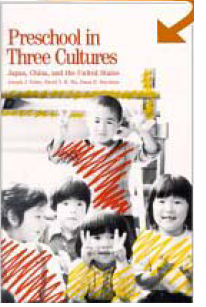Tobin, Wu and Davidson describe a day for 3-6 year olds at a preschool in China in the 1980s.

At 7:45 on … Monday morning in early spring parents pull up to the school’s front gate on bicycles, each carrying a brightly dressed child riding on the back …
Two columns of desks, each with an attached bench large enough for two students, run down the middle of the classroom. In front of the room are a blackboard, a calendar, and a chart of Chinese characters.
After singing a … song … the children are asked to sit down at their desks … [T]he teachers distribute wooden parquetry blocks to each child. The blocks come in a small box, which also contains picture of several structures that can be made with them. Ms Xiang [the teacher] says to the students:
We all know how to build with blocks, right? Just pay attention to the picture of the building and build it. When we play games like this, we must use our minds, right? Once you are done, raise your hand and one of us will come by and check to make sure you’ve done it correctly. Begin. Do your best. Build according to order.
The children begin to work in silence. Those who are working in a nonorderly way are corrected: a child whose box is placed askew on her desk has it placed squarely in the desk’s upper right-hand corner by Ms Xiang.
After three minutes one little girl, who apparently knows the blueprints by heart, completes construction of a multistoried house. Raising her right arm in the air, she calls in a soft voice, ‘Teacher, I’m done’. But teacher [and aides] do not hear her as they are busy helping less able builders.
Finally, Ms Xiang comes over and says to the … girl, ‘You’re done already? Well, take it apart and build another. After fifteen minutes of building, tearing down, and rebuilding, some of the children grow a bit restive, squirming in their chairs and whispering to their deskmates. Ms Wang says: ‘Keep still! There is no need to talk while you are working. Let’s work quietly.’
After twenty-minutes the … [aides], collect the boxes of blocks and put them back neatly in a cupboard. The other children face the front, hands on their desks …
[Next, the teacher] drills them in addition and subtraction. As she pins hand-painted paper apples onto a large piece of cardboard, the children count out loud in unison. With their teacher’s encouragement, children raise their hands to answer problems Ms Wang poses by adding or subtracting paper apples from the board. The students participate enthusiastically, each correctly answering at least one problem.
As the arithmetic lesson draws to a close, lunch is delivered … into the classroom … Ms. Xiang reminds the children to eat in silence and not to waste any food: ‘Don’t talk while you are eating. You must give full attention to your meal. Concentrate on your eating as much as you do on your studying. That’s the correct way to eat.’
Tobin, Joseph, David Wu and Dana Davidson. 1989. Preschool in Three Cultures: Japan, China, and the United States. New Haven: Yale University Press. pp.72–79. || Amazon || WorldCat
